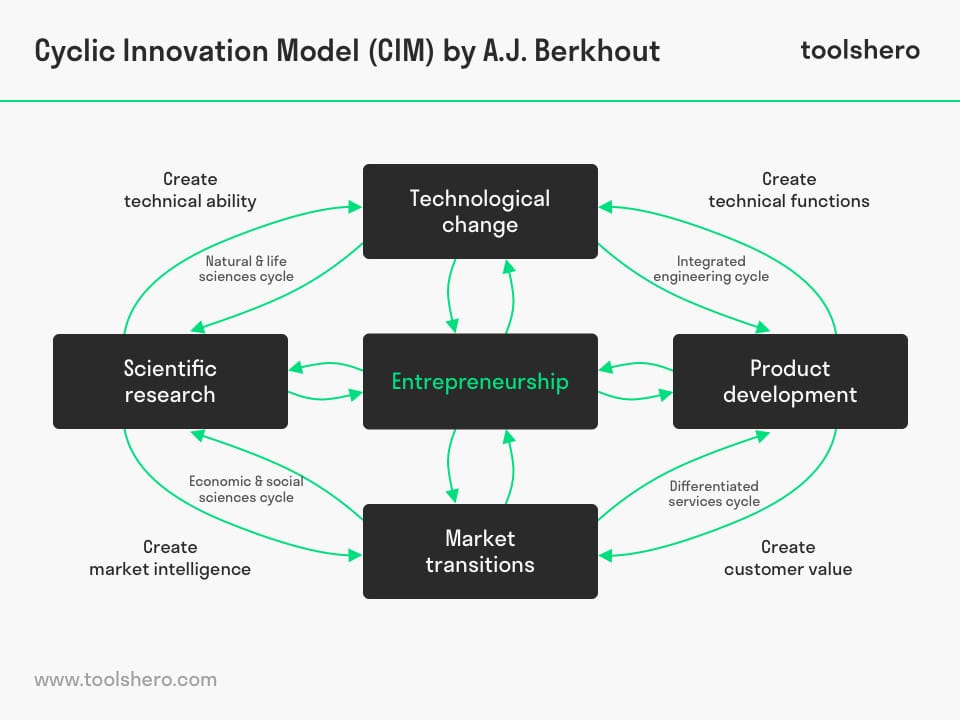Berkhout Cyclic Innovation Model (CIM)

Cyclic Innovation model: the Berkhout Cyclic Innovation Model (CIM) shows the different worlds, each playing its part in the innovation process, are closely intertwined. This article explains the concept of the Cyclic Innovation Model or CIM by Guus Berkhout (A. J. Berkhout) in a practical way. After reading it, you will understand the basics of this powerful innovation concept, what cyclic innovation entails and why it is necessary.
What is the Cyclic Innovation Model?
The Cyclic Innovation Model (CIM) is a patented brand by A. J. Berkhout (2007). The model shows that open innovation is not linear, but cyclical.
In the model, the different worlds, each playing its part in the innovation process, are closely intertwined. Unlike a linear innovation model, the Cyclic Innovation Model no longer only considers technological development and investments. It is the coherent whole of (economic) variables that is, according to this model, the key to successful innovation.
The Cyclic Innovation Model consists of 4 different worlds working together: the technological sector (top), the business sector (right), the market of these businesses (bottom) and the science (left). At the center of the model are the entrepreneurs. The entrepreneurs bring new information and ideas into the model after they have discovered a need for them.
What does the interaction between these worlds look like?
As shown in the visualisation of CIM, the Cyclic Innovation Model, different (communication) streams start to work when the different worlds work together. For example, when a desire or a problem is diagnosed in the society, it is necessary that this is communicated to the other worlds.
This way, not only the society is working on a solution, but knowledge, ideas and capital from other worlds are combined and the capacity of innovation is increased. This is essential to innovate purposefully.
The following sections describe the dynamics between the different worlds:
1: Scientific research/technological change (natural & life sciences cycle)
In the current consumer society, demand and therefore supply are growing. Every new smart phone has to be equipped with the latest technology.
Obviously, these features do not appear out of thin air. With solid knowledge from the scientific world, for example, the hardware to scan fingerprints was developed.
2. Technological change/ product development (integrated engineering cycle)
The engineer working at the smart phone company in question, in turn, ensures that the feature is made ready to be introduced in the new generation of smart phones: product innovation.
3. Product development/ market transitions (differentiated services cycle)
The need to unlock a smart phone with a fingerprint scanner comes from society, the market. The need for protection against the water along the shore of the Netherlands naturally also comes from society. These needs are then responded to by the other players in the Cyclic Innovation Model.
4. Market transitions/scientific research (economic & social sciences cycle)
New scientific insights ensure that changes in supply and demand are clearly mapped out. These insights are formed by carefully analysing social-economic processes and new investments in products and/or services.
The fewer barriers there are between these worlds, the faster the flow of knowledge, ideas, products and capital gets under way and the greater the innovative power. It is important to note that the flow should be able to move freely throughout the system. The Cyclic Innovation Model invites you to innovate both to the left and to the right.
Barriers are often formed by outdated institutions that benefit from keeping innovations off the market. The disruptive effect that then occurs can be restored by market forces, but in the case of innovations relating to society, the government has a leading and responsible role.
Cyclic Innovation Model: from a linear to a cyclical vision
Nowadays the cyclical model is preferred. However, many innovative processes and developments are still linear. Too often, it is believed that only innovation in the technological sector can lead to innovation.
The innovations do need to be placed in the right context, so the value of the innovation becomes clear. This is possible after research into market transitions or societal needs.
An example of an invention, which was developed and spread out according to the Cyclic Innovation Model, is the binary number system. The binary number system is used for calculations in nearly every computer.
The system, in which the numbers 1 and 0 are used, was developed by the German scientist Gottfried Wilhelm von Leibnits (1672). The technique was then applied in products (computers) and changed society in such a way that the other worlds were also motivated to start innovating in this field.
A linear innovation model focusses, as said, on the technological sector and the stream of investments. A consequence of this may be that the market is flooded with supply-driven products for which it has not been determined whether there is a demand.
Innovation is therefore surely not only a matter of a technological breakthrough, but the value creation must be clear. Still, it is difficult to identify this value creation beforehand, because value is added all throughout the innovation process.
Whether there is a demand for the product or service or not, value is created somewhere in the Cyclic Innovation Model, which can lead to new innovations.
Cyclic Innovation Model summary
After the transition from linear to cyclical innovations, the developments that ensure progress are gaining momentum. Because the greats work together, the capacity to innovate is purposefully increased.
Before the collective of worlds starts innovating, it is necessary that the value creation has been clearly identified. This is important to prevent the market from flooding with supply-driven products or services and more emphasis can be put in the societal benefit of innovation.
It’s Your Turn
What do you think? What are your experiences with the Cyclic Innovation Model or CIM? Do you recognize the practical explanation or do you have more suggestions? Do you use the cyclical model in your business life or are you depending on linear methods?
Share your experience and knowledge in the comments box below.
More information
- Berkhout, A. J., Hartmann, D., Van Der Duin, P., & Ortt, R. (2006). Innovating the innovation process. International journal of technology management, 34(3-4), 390-404.
- Berkhout, A. J., & Van Der Duin, P. A. (2007). New ways of innovation: an application of the cyclic innovation model to the mobile telecom industry. International Journal of Technology Management, 40(4), 294-309.
- A.J. Berkhout his website, portfolio and list of publications: https://www.aj-berkhout.com
How to cite this article:
Janse, B. (2018). Cyclic Innovation Model (CIM) by A.J. Berkhout. Retrieved [insert date] from ToolsHero: https://www.toolshero.com/innovation/berkhout-cyclic-innovation-model-cim/
Add a link to this page on your website:
<a href=”https://www.toolshero.com/innovation/berkhout-cyclic-innovation-model-cim/”>Toolshero: Cyclic Innovation Model (CIM) by A.J. Berkhout</a>
Published on: 21/05/2018 | Last update: 15/02/2022








2 responses to “Berkhout Cyclic Innovation Model (CIM)”
Really appreciate the Holistic and Systems view you have taken in your model. For me it is reflective of Organizational Change placing your model, ever moving, along an X axis of Time, responding to the multiple curves that help drive an organization, hopefully, forward.
Thank you for your comment and sharing your experience Seymour.